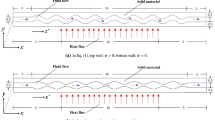Abstract
Hydrothermal waves in flows driven by thermocapillary and buoyancy effects are suppressed by applying a predictive control method. Hydrothermal waves arise in the manufacturing of crystals, including the “open boat” crystal growth process, and lead to undesirable impurities in crystals. The open boat process is modeled using the two-dimensional unsteady incompressible Navier–Stokes equations under the Boussinesq approximation and the linear approximation of the surface thermocapillary force. The flow is controlled by a spatially and temporally varying heat flux density through the free surface. The heat flux density is determined by a conjugate gradient optimization algorithm. The gradient of the objective function with respect to the heat flux density is found by solving adjoint equations derived from the Navier–Stokes ones in the Boussinesq approximation. Special attention is given to heat flux density distributions over small free-surface areas and to the maximum admissible heat flux density.
Similar content being viewed by others
References
H. C. Kuhlmann, Thermocapillary Convection in Models of Crystal Growth (Springer, Berlin, 1999).
J. Shiomi, G. Amberg, and H. Alfredsson, “Active control of oscillatory thermocapillary convection,” Phys. Rev. E 64, 031205–1–031205–7 (2001). doi 10.1063/1.1497375
J. Shiomi and G. Amberg, “Active control of a global thermocapillary instability,” Phys. Fluids 14 (9), 1063 (2002).
J. Shiomi et al., “Feedback control of oscillatory thermocapillary convection in a half-zone liquid bridge,” J. Fluid Mech. 496, 193–211 (2003). doi 10.1017/S0022112003006323
B. A. Bezuglyi, O. A. Tarasov, and A. A. Fedorets, RF Patent No. 2158898 RU, Tyumen. Gos. Univ. (1999).
A. F. Albu and V. I. Zubov, “Determination of functional gradient in an optimal control problem related to metal solidification,” Comput. Math. Math. Phys. 49 (1), 47–70 (2009).
V. N. Popov, “Numerical study of the effect of a surface active agent on convective mass transfer in laser surface melting of metal,” Mat. Mekh. Sploshn. Sredy 5 (3), 253–258 (2012). doi http://dx.doi.org/10.7242/1999-6691/2012.5.3.29
F. Muldoon, “Control of hydrothermal waves in a thermocapillary flow using a gradient-based control strategy,” Int. J. Numer. Methods Fluids 72 (1), 90–118 (2013). doi 10.1002/fld.3735
V. M. Shevtsova and J. Legros, “Instability in thin layer of liquid confined between rigid walls at different temperatures,” Acta Astronaut. 52, 541–549 (2003).
L. J. Peltier and S. Biringen, “Time-dependent thermocapillary convection in a rectangular cavity: Numerical results for a moderate Prandtl number fluid,” J. Fluid Mech. 257, 339–357 (1993). doi 10.1017/S0022112093003106
V. I. Polezhaev, A. V. Bune, N. A. Verezub, G. S. Glushko, V. L. Gryaznov, K. G. Dubovik, S. A. Nikitin, A. I. Prostomolotov, A. I. Fedoseev, and S. G. Cherkasov, Mathematical Simulation of Convective Heat and Mass Transfer Based on the Navier–Stokes Equations (Nauka, Moscow, 1987) [in Russian].
V. I. Polezhaev et al., Convective Processes in Zero Gravity (Nauka, Moscow, 1991) [in Russian].
H. Kuhlmann and S. Albensoeder, “Three-dimensional flow instabilities in a thermocapillary-driven cavity,” Phys. Rev. E 77, 036303–1–036303–15 (2008).
F. Muldoon, “Control of a simplified unsteady film-cooling flow using gradient-based optimization,” AIAA J. 46 (10), 2443–2458 (2008).
M. B. Giles et al., “Algorithm developments for discrete adjoint methods,” AIAA J. 41 (2), 198–205 (2003). doi 10.2514/2.1961
E. Nielsen, PhD Thesis (Virginia Polytechnic Institute, State University, 1998).
S. Nadarajah and A. Jameson, “Studies of the continuous and discrete adjoint approaches to viscous automatic aerodynamic shape optimization,” 15th Computational Fluid Dynamics Conference, Anaheim, CA, 2001, AIAA-2001-2530 (2001).
E. J. Nielsen, B. Diskin, and N. K. Yamaleev, “Discrete adjoint-based design optimization of unsteady turbulent flows on dynamic unstructured grids,” AIAA-2009-3802 (2009).
A. McNamara, A. Treuille, Z. Popovic, and J. Stam, “Fluid control using the adjoint method,” ACM Trans. Graphics (2004). http://grail.cs.washington.edu/projects/control/fiuidAdjoint.pdf.
Harwell Subroutine Library: A Collection of Fortran Codes for Large Scale Scientific Computation (Numerical Analysis Group, 2007).
T. R. Bewley, P. Moin, and R. Temam, “DNS-based predictive control of turbulence: An optimal benchmark for feedback algorithms,” J. Fluid Mech. 447, 179–225 (2001). doi 10.1017/S0022112001005821
J. Nocedal and S. J. Wright, Numerical Optimization (Springer, New York, 1999).
F. Muldoon, PhD Thesis (Louisiana State University, 2004).
Author information
Authors and Affiliations
Corresponding author
Additional information
Original Russian Text © F.H. Muldoon, 2018, published in Zhurnal Vychislitel’noi Matematiki i Matematicheskoi Fiziki, 2018, Vol. 58, No. 4, pp. 645–660.
Rights and permissions
About this article
Cite this article
Muldoon, F.H. Numerical Study of Hydrothermal Wave Suppression in Thermocapillary Flow Using a Predictive Control Method. Comput. Math. and Math. Phys. 58, 493–507 (2018). https://doi.org/10.1134/S0965542518040127
Received:
Accepted:
Published:
Issue Date:
DOI: https://doi.org/10.1134/S0965542518040127




